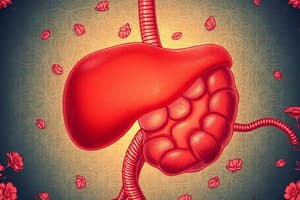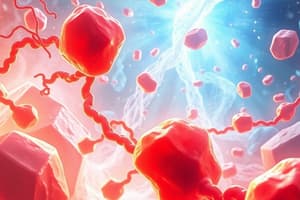Podcast
Questions and Answers
What is the main function of HDL cholesterol?
What is the main function of HDL cholesterol?
- To release cholesterol into the blood
- To absorb dietary cholesterol in the intestine
- To build up plaque in the arteries
- To remove cholesterol from the arteries (correct)
What is the normal range for Total Cholesterol in a healthy individual?
What is the normal range for Total Cholesterol in a healthy individual?
- 240-280 mg/dL
- 150-200 mg/dL (correct)
- 150-180 mg/dL
- 200-240 mg/dL
What is the primary source of cholesterol build-up and blockage in the arteries?
What is the primary source of cholesterol build-up and blockage in the arteries?
- VLDL Cholesterol
- Total Cholesterol
- HDL Cholesterol
- LDL Cholesterol (correct)
What is the reference range for VLDL Cholesterol in a healthy individual?
What is the reference range for VLDL Cholesterol in a healthy individual?
What is the term for the total amount of cholesterol in the blood?
What is the term for the total amount of cholesterol in the blood?
What is the reference range for a healthy HDL Cholesterol level?
What is the reference range for a healthy HDL Cholesterol level?
Which component is part of the hydrophilic surface of lipoproteins?
Which component is part of the hydrophilic surface of lipoproteins?
What is the main function of HDL in the body?
What is the main function of HDL in the body?
Apolipoproteins can be found in which structure?
Apolipoproteins can be found in which structure?
What distinguishes chylomicrons from other lipoproteins based on density?
What distinguishes chylomicrons from other lipoproteins based on density?
Which of the following does not have a specific function according to the classification of lipoproteins?
Which of the following does not have a specific function according to the classification of lipoproteins?
What is a distinct feature of esterified cholesterol?
What is a distinct feature of esterified cholesterol?
Which apolipoprotein is not correctly paired with its type?
Which apolipoprotein is not correctly paired with its type?
What is a major source of cholesterol in the plasma?
What is a major source of cholesterol in the plasma?
What classifies a disorder as primary dyslipidemia?
What classifies a disorder as primary dyslipidemia?
Which main lipoprotein is elevated in Familial Hypercholesterolemia?
Which main lipoprotein is elevated in Familial Hypercholesterolemia?
Which condition is NOT a risk factor for atherosclerosis?
Which condition is NOT a risk factor for atherosclerosis?
Which disorder is linked to Secondary Dyslipidemia?
Which disorder is linked to Secondary Dyslipidemia?
What is the primary characteristic of fatty liver disease?
What is the primary characteristic of fatty liver disease?
What is the main lipid elevated in Familial Hyperchylomicronemia?
What is the main lipid elevated in Familial Hyperchylomicronemia?
Which lipoproteins are elevated in Mixed Hypertriglyceridemia?
Which lipoproteins are elevated in Mixed Hypertriglyceridemia?
Which process is a primary cause of atherosclerosis?
Which process is a primary cause of atherosclerosis?
What condition is characterized by total cholesterol below normal levels?
What condition is characterized by total cholesterol below normal levels?
Which lipid measurement indicates a risk of atherosclerosis when elevated above 130 mg/dL?
Which lipid measurement indicates a risk of atherosclerosis when elevated above 130 mg/dL?
Which disorder is NOT associated with hypercholesterolemia?
Which disorder is NOT associated with hypercholesterolemia?
Which risk factor is common to both coronary heart disease and atherosclerosis?
Which risk factor is common to both coronary heart disease and atherosclerosis?
What is dyslipidemia mainly associated with?
What is dyslipidemia mainly associated with?
Which condition is associated with high levels of cholesterol and also affects the endocrine system?
Which condition is associated with high levels of cholesterol and also affects the endocrine system?
What condition is characterized by low levels of HDLC (< 40 mg/dL)?
What condition is characterized by low levels of HDLC (< 40 mg/dL)?
Which condition is NOT typically associated with hypocholesterolemia?
Which condition is NOT typically associated with hypocholesterolemia?
Study Notes
Plasma Cholesterol
- Total cholesterol is the sum of HDL, LDL, and VLDL cholesterol in the blood.
- HDL (good) cholesterol helps remove cholesterol from arteries, while LDL (bad) cholesterol is the main source of cholesterol buildup and blockage in arteries.
- VLDL cholesterol contributes to plaque buildup in arteries.
Reference Range
- Total cholesterol: 150-200 mg/dL (healthy), 200-240 mg/dL (at risk), > 240 mg/dL (dangerous)
- HDL cholesterol: > 60 mg/dL (healthy), 40-60 mg/dL (at risk), < 40 mg/dL (dangerous)
- LDL cholesterol: < 100 mg/dL (healthy), 100-130 mg/dL (at risk), > 130 mg/dL (dangerous)
- VLDL cholesterol: < 30 mg/dL (healthy), > 30 mg/dL (at risk)
Primary and Secondary Dyslipidemia
- Primary dyslipidemia occurs due to genetic disorders.
- Secondary dyslipidemia occurs due to diabetes mellitus, nephrotic syndrome, hypothyroidism, hypertension, and drug-induced causes.
Atherosclerosis
- Atherosclerosis is the thickening or hardening of arteries caused by plaque buildup.
- Risk factors include high cholesterol and triglyceride levels, high blood pressure, smoking, diabetes, obesity, and physical inactivity.
Cardiovascular Disease
- Cardiovascular disease is a disease of the heart or blood vessels.
- It can lead to reduced blood flow to the heart, brain, or body due to atherosclerosis and blood clots.
Fatty Liver Disease
- Fatty liver disease is a condition caused by excessive fat buildup in the liver.
- An accumulation of intrahepatic fat > 5% is dangerous to health.
Lipoproteins
- Lipoproteins are complex particles with a central hydrophobic core of triglycerides and cholesterol esters, a hydrophilic surface of phospholipids and free cholesterol, and apoproteins.
- Apolipoproteins are proteins that bind lipids to form lipoproteins.
Classification of Lipoproteins
- Lipoproteins are classified into five major types based on density: chylomicrons, VLDL, IDL, LDL, and HDL.
- Lipoproteins with high lipid content have low density and large size, while those with high protein content have high density and compact size.
Functions of Lipoproteins
- Chylomicrons transport dietary TG from the intestine to adipose tissue for storage and to muscle, heart, and brain for energy.
- VLDL transports endogenous TG from the liver to peripheral tissue for energy.
- LDL transports cholesterol from the liver to peripheral tissues.
- HDL transports cholesterol from peripheral tissues to the liver.
Sources of Plasma Cholesterol
- The liver is the main source of plasma cholesterol.
- Cholesterol can also come from dietary sources.
Clinical Importance of Plasma Cholesterol
- High levels of LDL-C (> 130 mg/dL) and low levels of HDL-C (< 40 mg/dL) are risk factors for coronary heart disease.
- High levels of VLDL-C (> 30 mg/dL) show the risk of atherosclerosis and coronary heart disease.
- Abnormal total cholesterol: HDL ratio shows the risk of atherosclerosis and coronary heart disease.
- Hypocholesterolemia (rare condition) is associated with hyperthyroidism, malabsorption, malnutrition, hemolytic jaundice, and inflammation.
Studying That Suits You
Use AI to generate personalized quizzes and flashcards to suit your learning preferences.
Description
Learn about plasma cholesterol values, unesterified and esterified cholesterol, and lipoproteins in blood plasma. Understand how lipids are transported in the blood as complexes with proteins.




